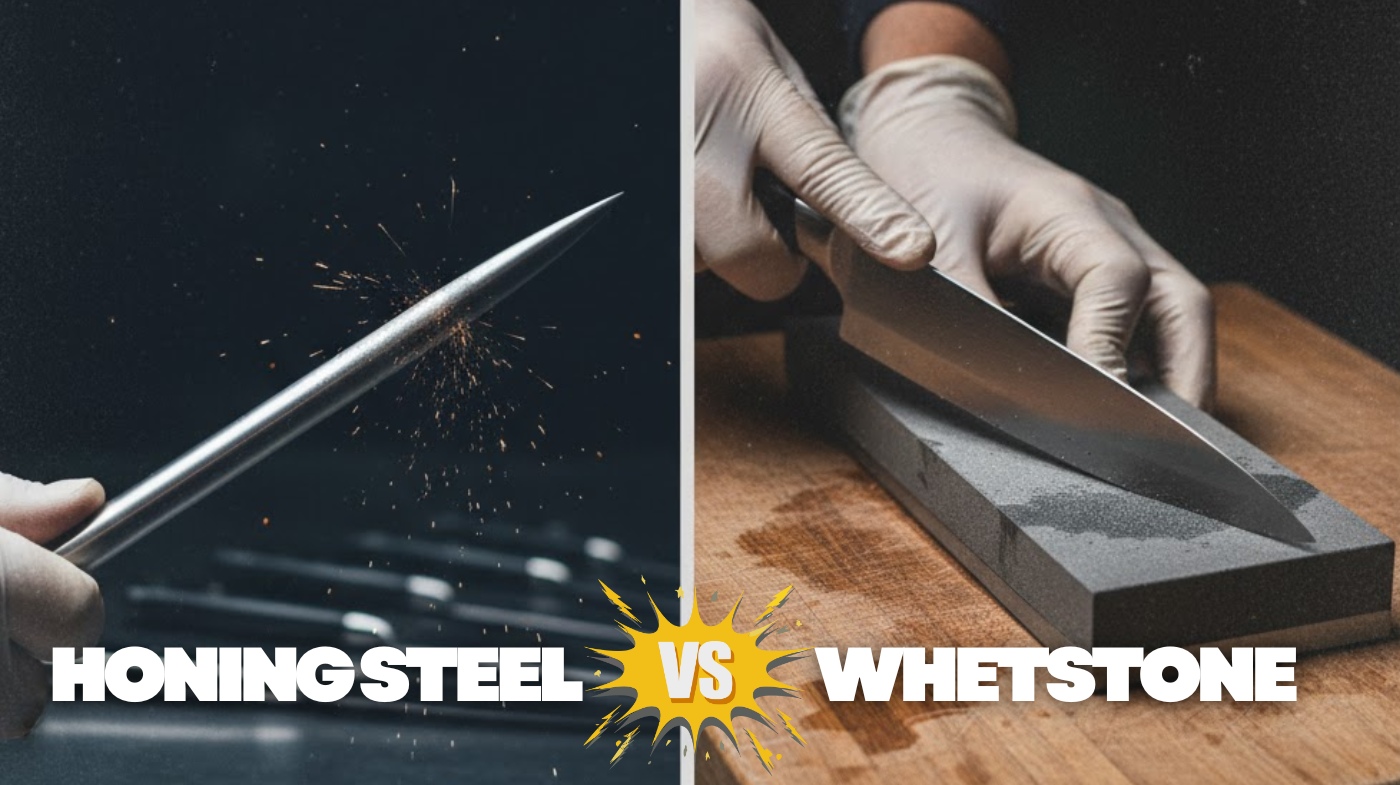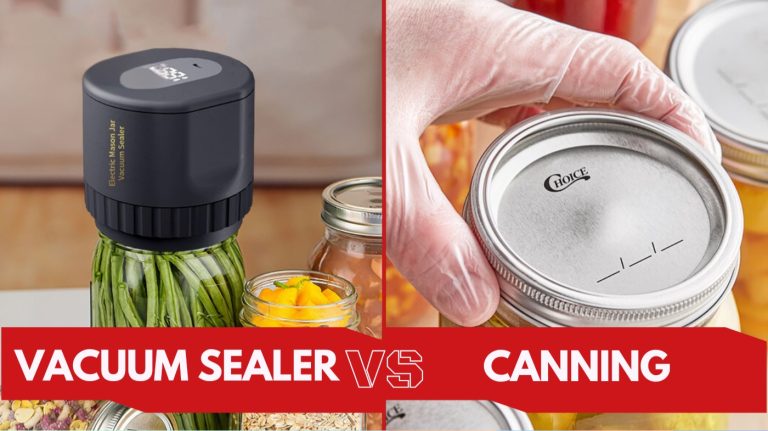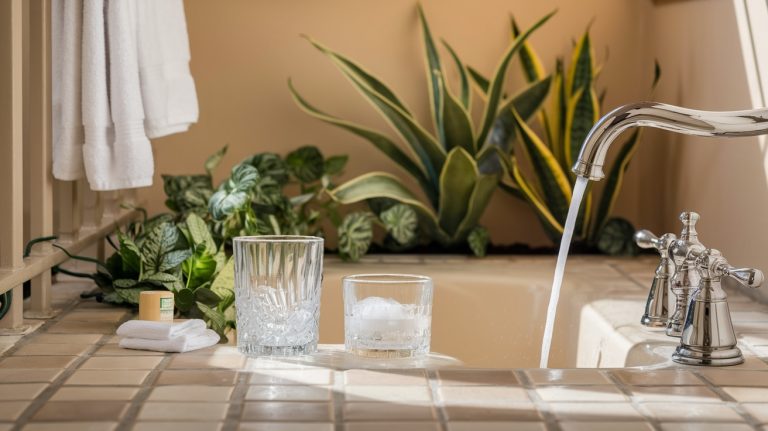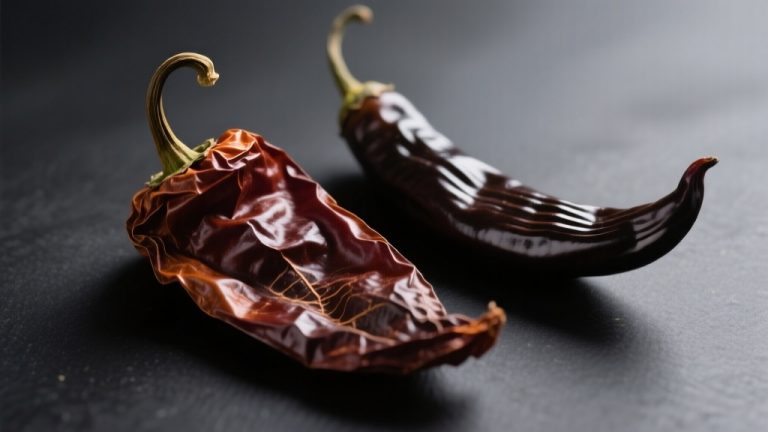Honing Steel vs Whetstone: Which Keeps Knives Sharper?
You use a honing steel daily to realign your knife’s edge without removing metal. This tool is ideal for softer Western blades and quick maintenance.
A whetstone, however, sharpens by grinding away metal. It is perfect for dull or damaged blades of all steel types, including hard Japanese knives.
Honing steels require less skill and upkeep, while whetstones demand practice but deliver finer, longer-lasting edges. Understanding these differences helps you maintain and restore your knives effectively and efficiently.
- Premium Steel Construction – The steel rod is made of carbon steel and plated with nickel-chrome;…
- Versatile Compatibility – Our knife sharpening steel rod is for all types of knives, including…
- Ergonomic Non-Slip Grip – Easy to use, with an ergonomic handle that fits your hand, be it right or…
- 【Complete Knife Sharpening Stone Kit】You don’t need to be a Pro to sharpen your blades, all you…
- 【Dual Sided Whetstone】Our wet stone is made of highly durable and professional-grade corundum…
- 【Multipurpose】Our professional-grade knife sharpener kit is highly durable & long-lasting….
Key Takeaways
- Honing steels realign blade edges without removing metal, ideal for daily maintenance and softer Western-style knives.
- Whetstones grind away metal to sharpen, repair, and polish blades, suitable for all steels including hard Japanese knives.
- Honing steels require minimal skill and upkeep, offering quick edge realignment with consistent 10–15° angle strokes.
- Whetstones demand higher skill, precise angle control, lubrication, and periodic flattening for effective sharpening and edge restoration.
- Use honing steels for frequent micro-adjustments and whetstones for periodic comprehensive sharpening and repairing damaged edges.
Comparison Table: Honing Steel Versus Whetstone
| Feature | Honing Steel | Whetstone |
|---|---|---|
| Primary Function | Realigns blade edge without removing metal | Sharpens by removing metal to reshape and refine the edge |
| Material | Steel, ceramic, or diamond-coated rod | Natural or synthetic abrasive stone |
| Edge Effect | Maintains sharpness temporarily | Restores dull or damaged edges fully |
| Metal Removal | Minimal to none | Moderate to significant depending on grit |
| Skill Level | Beginner-friendly | Requires skill and angle precision |
| Frequency of Use | Daily or weekly | Every few months or as needed |
| Maintenance Needs | Simple cleaning; low upkeep | Requires soaking, flattening, and drying |
| Knife Compatibility | Softer Western-style steels (HRC 54–58) | Suitable for all steels, including hard Japanese (HRC 60+) |
| Result Longevity | Short-term sharpness retention | Long-lasting, razor-sharp results |
| Time Required | Quick (under a minute) | Longer, involves setup and practice |
Purpose and Function of Honing Steel
Although often confused with sharpening tools, honing steel primarily serves to realign the microscopic teeth of your knife’s edge rather than remove metal.
When you use honing steel, you straighten bent or curled edge teeth caused by daily use, restoring the blade’s fine shape without grinding. This realignment creates a micro-bevel, enhancing cutting efficiency and preventing your knife from catching on food. Using honing steel regularly also helps in extending knife lifespan by maintaining edge integrity without removing metal.
Unlike sharpening stones, which remove metal to restore a dull edge, honing steels maintain sharpness through edge alignment. Steel rods usually feature longitudinal ridges to aid this process, while ceramic and diamond-coated variants provide minimal abrasive action for slight metal removal.
Regular honing, even daily, keeps your blade effective, extending time between full sharpening sessions. This practice is critical for maintaining precise, safe cutting performance. Typically, honing is performed immediately before or after using a knife to ensure optimal sharpness throughout use daily maintenance.
Purpose and Function of Whetstone
When you use a whetstone, you’re actually taking off some material from the blade to get that sharp edge back. It’s like giving your knife a little makeover. This process involves some controlled abrasion that reshapes the blade’s bevel, which helps fix any dullness or imperfections it might’ve picked up over time.
Whetstones offer precise control over sharpening angle and pressure, allowing you to restore even damaged or heavily dulled blades effectively. Understanding how this works really shows why whetstones are a must-have if you want to keep your edges in top shape.
After all, a sharp knife makes all the difference in the kitchen, doesn’t it? Proper tools and techniques are essential, much like choosing the right energy-efficient lighting to maintain a well-functioning kitchen environment.
Sharpening Mechanism Explained
Because sharpening with a whetstone involves grinding away microscopic amounts of metal, you gain precise control over the blade edge geometry. This allows you to tailor the sharpness to your specific needs.
You maintain a consistent sharpening angle, commonly 15 to 20 degrees, while applying even pressure and using smooth, long strokes along the stone’s surface. This technique is similar in precision to selecting the correct sharpness level in culinary applications.
As you sharpen, a burr forms on the opposite edge, signaling sufficient metal removal and guiding you to switch sides or refine the edge with finer grits.
The stone’s abrasive surface, combined with moisture to create a slurry, facilitates controlled metal abrasion without compromising blade integrity. Coarse grit stones, which range from 80-200 grit, are ideal for heavily damaged or very dull blades and require soaking in water for at least 10 minutes before use, helping to prepare the stone for effective sharpening.
This methodical process repairs imperfections and establishes a razor-sharp edge, making whetstone sharpening the preferred technique for precise, durable blade maintenance.
Material Removal Process
Sharpening with a whetstone relies on controlled material removal at a microscopic level, achieved through the stone’s abrasive surface. You’ll use abrasive particles embedded in the stone to grind away extremely thin metal layers from the blade edge, preserving its geometry and integrity.
Whetstones can be made from either natural stones such as Arkansas or Japanese water stones, or synthetic materials like aluminum oxide, allowing for tailored sharpening characteristics.
Selecting the right grit—from coarse (80–200) for reshaping to ultra-fine (5000+) for polishing—determines how aggressively metal is removed. Maintaining a consistent angle and pressure ensures even abrasion. Just as using the correct heat-resistant silicone spatula enhances blending efficiency, precise technique with a whetstone ensures optimal sharpening results.
The slurry formed by water and metal particles enhances cutting efficiency and lubrication. You must rinse accumulated filings regularly to prevent clogging.
Properly flattened stones deliver uniform results, avoiding uneven sharpening. This precise removal process minimizes metal loss, extends blade life, and maintains edge sharpness without affecting temper or hardness.
Edge Restoration Benefits
Although edge restoration demands skill and attention, using a whetstone grants you precise control over the sharpening angle and metal removal.
This control is vital to maintain the blade’s original geometry while effectively removing dull or damaged metal. Whetstones allow you to repair chips by gradually smoothing imperfections and restoring sharpness through progressive grit selection, from coarse to fine.
You’ll notice burr formation, signaling proper edge reformation. Understanding the grit progression ensures each sharpening stage effectively removes scratches from the previous grit for a polished edge. Unlike electric sharpeners, whetstones minimize unnecessary metal loss, preserving blade longevity.
Their portability and variety, including water stones, oil stones, diamond, ceramic, and synthetic options, offer versatility tailored to different blades and sharpening needs. Choosing materials with appropriate abrasive properties ensures efficient and safe sharpening without damaging the blade.
Differences in Material and Abrasiveness
When comparing honing steels and whetstones, you’ll notice they differ markedly in both material composition and abrasiveness.
Whetstones consist of natural quarried rock or synthetic compounds like aluminum oxide and silicon carbide, offering a spectrum of grit from coarse to fine. This versatility enables both aggressive sharpening and delicate polishing by material removal.
Historically, whetstones have been used since 79 AD and are closely linked to traditional sword crafting. Their ability to provide precise edge refinement contrasts with tools designed primarily for maintenance.
In contrast, honing steels are typically forged from steel, occasionally coated with ceramic or diamond abrasives, which provide minimal material removal. Their primary function is edge realignment rather than sharpening, resulting in considerably lower abrasiveness. This makes honing steels ideal for quick touch-ups and prolonging the time between full sharpenings.
While whetstones demand periodic flattening for consistent performance, honing steels maintain their surface with minimal upkeep.
Whetstones require regular flattening, whereas honing steels need minimal maintenance to keep their surface effective.
Understanding these material and abrasive distinctions helps you select the appropriate tool for maintaining your knife’s edge effectively. This knowledge is essential for balancing performance and durability in your kitchen tools.
Compatibility With Knife Types
Because different knives feature varying steel hardness and blade construction, choosing between honing steels and whetstones hinges on compatibility with your knife type.
Honing steels excel for softer Western-style knives with moderate hardness (HRC 54-58), realigning edges without material removal. Their effectiveness is limited by the grain structure of the steel, as coarser grains found in stainless steel can reduce honing precision.
For best results, regular maintenance using a honing steel should be combined with proper cleaning and care to prevent blade corrosion.
Whetstones suit a broader spectrum, including hard Japanese steels (HRC 60+) and damaged blades, by precisely reshaping edges through abrasion.
Use honing steels for carbon and stainless steels needing frequent edge realignment without sharpening. Avoid honing steels on brittle, hard Japanese knives to prevent edge damage.
Select whetstones to restore chips or achieve razor-sharp precision on all blade types. Match whetstone grit to steel hardness for controlled material removal and edge refinement. This technical fit ensures ideal edge maintenance and knife longevity.
Frequency and Technique of Use
Maintaining your knife’s edge requires understanding how often and how to use honing steels and whetstones effectively.
You should hone your knife before or after each use or at least once or twice weekly for frequent use. Regular honing works by gently pushing the blade’s edge back into alignment, which restores sharpness without removing metal. This regular maintenance is crucial for preserving blade life and ensuring optimal cutting performance.
Hold the blade at a 15-20 degree angle and apply steady, controlled strokes on the honing rod to realign the edge.
For high-usage knives, hone daily to preserve sharpness.
Sharpening with a whetstone, by contrast, is less frequent—typically every 6 to 12 months depending on use and blade quality.
Soak the stone, maintain a consistent 15-20 degree angle, and progress through grits from coarse to fine for precise edge restoration.
Frequent honing minimizes sharpening needs, extending blade life while sharpening removes metal and demands more skill and time.
Maintenance and Care Requirements
Although honing steels and whetstones serve different sharpening purposes, both demand consistent maintenance to guarantee peak performance and longevity.
You must clean honing steels regularly with a damp cloth and vinegar to remove metal filings and grease. Air drying after cleaning helps prevent rust and maintain the steel’s effectiveness.
Whetstones require thorough rinsing and drying after use to eliminate slurry and prevent cracking or mold.
Proper storage in dry conditions and protective holders preserves their functional surfaces. Clean honing steels to avoid clogging and test grip by sliding a blade tip.
Rinse and flatten whetstones regularly to maintain flatness and abrasive efficiency. Store tools separately, ensuring honing steels remain dry to prevent corrosion. Limit whetstone use to necessary sharpening to extend blade and tool lifespan.
Consistent care ensures reliable edge realignment and sharpening results. Additionally, storing knives properly in a knife block or magnetic strip helps maintain their sharpness and prevents damage to the blade during honing or sharpening with whetstones.
Skill Level Needed for Effective Use
Honing steel is pretty user-friendly! You really just need to keep that angle consistent—around 20°—to get those edges realigned nicely. It’s not too complicated, which is great for anyone who wants a quick fix for their knife. However, it has a limited ability to sharpen dull blades and is primarily used for maintenance rather than full sharpening. Its simplicity makes it ideal for quick touch-ups but not for comprehensive blade restoration.
Now, when it comes to using a whetstone, that’s a whole different ball game. You’ve got to have a good handle on your sharpening angles, choose the right grit, and apply just the right amount of pressure. It’s all about reshaping and sharpening those blades without causing any damage.
Honestly, mastering a whetstone can be quite the challenge. It takes a bit of practice and advanced motor skills, so it’s definitely more suited for those who are really looking for that high level of precision in their sharpening game. For those serious about blade care, understanding material types can enhance the sharpening process.
Honing Steel Simplicity
Since honing steel requires only a consistent angle of about 15 to 20 degrees and simple, repetitive strokes, you don’t need advanced skills or extensive training to use it effectively.
Its design emphasizes ease and speed, making it accessible for both novices and professionals for routine edge maintenance. You’ll find no need for complex motion control or grit progression.
Key points about honing steel simplicity include:
- Minimal risk of blade damage even with incorrect use
- No preparation or soaking required before use
- Fast operation, often under a minute, fitting seamlessly into workflow
- Ergonomic, non-slip handles enhance safety and control
Because honing rods help realign the blade’s microscopic teeth, they maintain edge sharpness without removing metal, contributing to blade longevity.
This straightforward technique enables frequent upkeep without interrupting kitchen tasks or demanding specialized expertise.
Whetstone Precision Skills
When using a whetstone, maintaining precise sharpening angles between 10° and 15° demands consistent practice and fine motor control to achieve ideal edge sharpness. You must understand blade geometry and select angles tailored to knife type and use.
Developing muscle memory ensures consistent strokes, while mastering grit progression from coarse to fine prevents excessive metal removal. It is also important to soak the stone for 10-15 minutes before sharpening to lubricate and release abrasive particles, which enhances the sharpening process.
| Skill Aspect | Requirement |
|---|---|
| Angle Control | Consistent 10°-15° angle maintenance |
| Grit Selection | Appropriate progression for edge needs |
| Stone Handling | Steady pressure and lubrication control |
| Practice | Regular, focused sessions for mastery |
Without disciplined training, maintaining edge quality and longevity is challenging. Your proficiency directly influences cutting performance and blade durability.
Practical Benefits and Limitations
Although honing steels and whetstones serve related purposes in blade maintenance, they offer distinct practical benefits and limitations that affect how and when you should use each tool.
Honing steels and whetstones both maintain blades but differ in use, benefits, and timing.
Honing steels realign blade edges without removing metal, making them ideal for frequent, quick maintenance. However, they don’t sharpen dull knives. Whetstones sharpen by grinding away steel, restoring edges and providing superior sharpness.
They require skill, time, and preparation. The choice between these tools also depends on the blade material, as Japanese chef knives often benefit more from whetstone sharpening with water, while Western-style knives respond well to honing steel use.
Use honing steels daily for rapid edge realignment on Western-style knives. Rely on whetstones for periodic sharpening, edge repair, and polishing.
Avoid honing steels on very hard or brittle steels to prevent chipping. Expect whetstones to need lubrication and flattening to maintain performance.
Choosing the Right Tool for Your Needs
Deciding between honing steel and whetstone depends largely on your knife’s steel type, intended use, and maintenance frequency.
If your knives are softer Western steel, honing steel suits daily realignment. For hard or Japanese blades, whetstones provide controlled sharpening without chipping risk. Remember that sharpening fixes knicks and chips on the blade, while honing re-aligns the edge to maintain sharpness.
Consider your skill level and convenience needs before choosing.
| Factor | Honing Steel | Whetstone |
|---|---|---|
| Blade Compatibility | Softer Western steels | All blade types, including Japanese |
| Maintenance Frequency | Daily realignment | Monthly or as needed sharpening |
| Skill Required | Low to moderate | High, angle control critical |
| Portability | Compact, quick use | Bulkier, requires setup |
| Edge Result | Maintains existing edge | Restores dull or damaged edges |
Match tool choice to your knives and usage for ideal edge care.
Frequently Asked Questions
Can Honing Steels Damage Serrated Knife Edges?
Yes, honing steels can damage serrated knife edges if you use the wrong type.
Regular grooved steel rods are often too soft or abrasive for serrations, causing chipping or uneven wear.
To avoid damage, you should use tapered ceramic or diamond rods that fit each serration groove precisely and apply light pressure.
This approach realigns and lightly sharpens without deforming or prematurely wearing down the serrated teeth.
Are There Safety Concerns When Using a Honing Steel?
Yes, you need to be cautious when using a honing steel.
Slips can cause serious cuts if your fingers stray onto the blade.
Applying too much force or holding the steel at inconsistent angles increases accident risk.
To stay safe, always maintain a steady grip, use controlled motions, and keep your hands clear of the blade path.
Wearing cut-resistant gloves and following proper technique will protect you from injury.
How Does Humidity Affect Whetstone Performance?
Humidity affects your whetstone by softening its surface, which reduces abrasive efficiency and demands more force, risking edge damage.
Excess moisture weakens binders, causing cracks or breakage, and promotes mold growth if stored damp.
Fluctuating humidity alters stone hardness, disrupting consistent sharpening.
To maintain performance, you must dry the stone thoroughly, store it in ventilated conditions, and adjust your technique to compensate for these environmental changes.
Can Honing Steels Be Used on Kitchen Scissors?
You might think honing steels can rescue your kitchen scissors, but they’re not quite the right dance partners.
Their design suits straight-edged knives, not the unique curves and serrations of scissors.
Using them risks dulling or damaging your blades.
Instead, rely on dedicated scissor sharpeners or whetstones for precise edge restoration.
Stick to professional methods to maintain your scissors’ cutting performance safely and effectively.
Is There a Best Storage Method for Whetstones?
Yes, the best way to store whetstones is in a cool, dry place with stable temperature and humidity. Avoid direct sunlight and heat sources that cause cracking.
Use containers with airflow, like wooden boxes or plastic cases with air holes, and never stack stones.
Always dry your whetstones fully before storing, and keep them away from damp environments to prevent mold and damage.
Proper storage extends their lifespan and maintains performance.
Honing Steel or Whetstone — What Will You Master Next?
When it comes to keeping your knives sharp, remember: “A stitch in time saves nine.” Honing steel realigns edges quickly, ideal for frequent upkeep, while whetstones remove metal to restore sharpness, perfect for dull blades.
Choose honing steel for daily maintenance, whetstones for deep sharpening. Understanding their material, technique, and care ensures precision and longevity. Use the right tool consistently, and you’ll maintain ideal blade performance with minimal effort and maximum control.
- ✔️ DIAMOND ELECTOPLATING: State-of-the-art manufacturing for precision Kitchen, Home or Hunting…
- ✔️ OVAL SHAPE: This knife sharpener rod is designed to ensure higher sharpening efficiency.
- ✔️ LIGHTER TOUCH: Requires much less force than most sharpening steel. ‘Easy-does-it” leads to…
- Made with superior silicon carbide, the 400 grit side is suitable for any daily sharpening, such as…
- No oil needed, just put the stone into water for 10-15 minutes before using and they are ready to…
- One stone, unlimited professional knives. whetstone are compatible with all kinds of knives,…
Last update on 2025-12-08 / Affiliate links / Images from Amazon Product Advertising API











